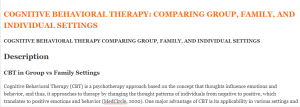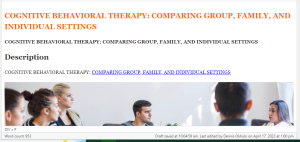COGNITIVE BEHAVIORAL THERAPY: COMPARING GROUP, FAMILY, AND INDIVIDUAL SETTINGS
COGNITIVE BEHAVIORAL THERAPY COMPARING GROUP, FAMILY, AND INDIVIDUAL SETTINGS
Description
CBT in Group vs Family Settings
Cognitive Behavioral Therapy (CBT) is a psychotherapy approach based on the concept that thoughts influence emotions and behavior, and thus, it approaches to therapy by changing the thought patterns of individuals from negative to positive, which translates to positive emotions and behavior (MedCircle, 2020). One major advantage of CBT is its applicability in various settings and its use in multiple mental health conditions. The application of CBT principles and approach have variations from one setting to another, for example, group application is different from how it is used in family settings.
Group CBT vs Family CBT
In group therapy, CBT brings together people with similar problems to change their maladaptive thought patterns into positive thinking. Thus, the focus of CBT in group therapy is sharing so that individuals can learn from each other’s experiences and change their own way of thinking and adopt a positive approach toward life (Yusop et al., 2020). Thus, the interactions between the members bring therapeutic effect because of the chance to share challenges and find solutions within the group. Moreover, in CBT group therapy, the therapist must cultivate the relationship between himself/herself and the group, and at the same time ensure and healthy relationship with the individual members. In group CBT, the involvement of the therapist is minimal as the group members take charge of being each other’s therapists through sharing experiences, encouraging one another, giving hope, and providing unlimited support (Amoke et al., 2020).
On the other hand, family CBT is applied to a group of people with various issues impacting relationships and communication patterns among the members (MedCircle, 2020). Thus, CBT in a family setting focuses more on the interaction between feelings, and emotions, and how they influence the behavior of individual family members. The goal of family CBT is to create an atmosphere where the family members can connect and improve the atmosphere on how they relate to one another. The role of the therapist in this is to support the family to adopt positive thinking patterns and develop healthy relationships while learning effective ways to communicate with one another (Dalle et al., 2019). Thus, the therapy is more involved compared to group therapy. An example of family therapy I have witnessed is a family of three children and a mother. One of the children was an adolescent with behavioral issues, which started after their parents divorced. Finally, family CBT tailors the therapy to meet the specific needs of each family member.
Challenges of Family CBT
One of the challenges therapist face with family CBT is a lack of motivation. For example, when working with teenagers and other

stubborn family members, they may be unwilling to change while the rest of the family is on board with the therapy. The second challenge is when the family members understand the concept and what they need to do, they just fail to alter their thinking patterns. This is because change takes time to reinforce, and it might even require a longer time in some people.
Sources
- A conceptual comparison of family-based treatment by Dalle et al. (2019) is scholarly because it is a peer-reviewed journal article. The evidence is based on a thorough examination of literature giving the source credibility.
- The Effectiveness of Cognitive Behavioral Therapy in Group Counselling by Yusop et al. (2020) is scholarly because it is peer-reviewed and provides a strong evidential background on CBT group therapy based on data collected from studies.
- Effects of group cognitive-behavioural therapy on psychological distress by Amoke et al. (2020) is scholarly because it is a study, which means it provides information based on a primary collection of data, which reduces the unreliability of information. Additionally, the study uses unbiased approaches, enhancing the accuracy of collected data.
COGNITIVE BEHAVIORAL THERAPY: COMPARING GROUP, FAMILY, AND INDIVIDUAL SETTINGS References
Amoke, C. V., Ede, M. O., Nwokeoma, B. N., Onah, S. O., Ikechukwu-Ilomuanya, A. B., Albi-Oparaocha, F. C., . . . Amadi, K. (2020). Effects of group cognitive-behavioral therapy on psychological distress of awaiting-trial prison inmates. Medicine, 99(17) – p e18034. https://doi.10.1097/MD.0000000000018034.
Dalle, R., Eckhardt, S., & Calugi, S. (2019). A conceptual comparison of family-based treatment and enhanced cognitive behavior therapy in the treatment of adolescents with eating disorders. J Eat Disord, 7, 42. https://doi.org/10.1186/s40337-019.
MedCircle. (2020). What a Cognitive Behavioral Therapy (CBT) Session Looks Like. Retrieved from YouTube: https://www.youtube.com/watch?v=8-2WQF3SWwo
Yusop, Y. M., Rahman, N., Zainudin, Z., Ismail, A., Othman, W., & Sumari , M. (2020). The Effectiveness of Cognitive Behavioral Therapy in Group Counselling. International of Academic Research, Business, and Social Sciences, 360-371.
Click here to ORDER an A++ paper from our Verified MASTERS and DOCTORATE WRITERS:COGNITIVE BEHAVIORAL THERAPY: COMPARING GROUP, FAMILY, AND INDIVIDUAL SETTINGS
There are significant differences in the applications of cognitive behavior therapy (CBT) for families and individuals. The same is true for CBT in group settings and CBT in family settings. In your role, it is essential to understand these differences to appropriately apply this therapeutic approach across multiple settings. For this Discussion, as you compare the use of CBT in individual, group, and family settings, consider challenges of using this approach with groups you may lead, as well as strategies for overcoming those challenges.
RESOURCES

Be sure to review the Learning Resources before completing this activity.
Click the weekly resources link to access the resources.
WEEKLY RESOURCES
To prepare:
Review the videos in this week’s Learning Resources and consider the insights provided on CBT in various settings.
BY DAY 3
Post an explanation of how the use of CBT in groups compares to its use in family or individual settings. Explain at least two challenges PMHNPs might encounter when using CBT in one of these settings. Support your response with specific examples from this week’s media and at least three peer-reviewed, evidence-based sources. Explain why each of your supporting sources is considered scholarly and attach the PDFs of your sources.
Read a selection of your colleagues’ responses.
BY DAY 6 OF WEEK 1
Respond to at least two of your colleagues by recommending strategies to overcome the challenges your colleagues have identified. Support your recommendation with evidence-based literature and/or your own experiences with clients.
COGNITIVE BEHAVIORAL THERAPY: COMPARING GROUP, FAMILY, AND INDIVIDUAL SETTINGS Grid View
| Excellent | Good | Fair | Poor | ||
| Main Postinga | 45 (45%) – 50 (50%)
Answers all parts of the discussion question(s) expectations with reflective critical analysis and synthesis of knowledge gained from the course readings for the module and current credible sources.
Supported by at least three current, credible sources.
Written clearly and concisely with no grammatical or spelling errors and fully adheres to current APA manual writing rules and style. |
40 (40%) – 44 (44%)
Responds to the discussion question(s) and is reflective with critical analysis and synthesis of knowledge gained from the course readings for the module.
At least 75% of post has exceptional depth and breadth.
Supported by at least three credible sources.
Written clearly and concisely with one or no grammatical or spelling errors and fully adheres to current APA manual writing rules and style. |
35 (35%) – 39 (39%)
Responds to some of the discussion question(s).
One or two criteria are not addressed or are superficially addressed.
Is somewhat lacking reflection and critical analysis and synthesis.
Somewhat represents knowledge gained from the course readings for the module.
Post is cited with two credible sources.
Written somewhat concisely; may contain more than two spelling or grammatical errors.
Contains some APA formatting errors. |
0 (0%) – 34 (34%)
Does not respond to the discussion question(s) adequately.
Lacks depth or superficially addresses criteria.
Lacks reflection and critical analysis and synthesis.
Does not represent knowledge gained from the course readings for the module.
Contains only one or no credible sources.
Not written clearly or concisely.
Contains more than two spelling or grammatical errors.
Does not adhere to current APA manual writing rules and style. |
|
| Main Post: Timeliness | 10 (10%) – 10 (10%)
Posts main post by day 3. |
0 (0%) – 0 (0%) | 0 (0%) – 0 (0%) | 0 (0%) – 0 (0%)
Does not post by day 3. |
|
| First Response | 17 (17%) – 18 (18%)
Response exhibits synthesis, critical thinking, and application to practice settings.
Responds fully to questions posed by faculty.
Provides clear, concise opinions and ideas that are supported by at least two scholarly sources.
Demonstrates synthesis and understanding of learning objectives.
Communication is professional and respectful to colleagues.
Responses to faculty questions are fully answered, if posed.
Response is effectively written in standard, edited English. |
15 (15%) – 16 (16%)
Response exhibits critical thinking and application to practice settings.
Communication is professional and respectful to colleagues.
Responses to faculty questions are answered, if posed.
Provides clear, concise opinions and ideas that are supported by two or more credible sources.
Response is effectively written in standard, edited English. |
13 (13%) – 14 (14%)
Response is on topic and may have some depth.
Responses posted in the discussion may lack effective professional communication.
Responses to faculty questions are somewhat answered, if posed.
Response may lack clear, concise opinions and ideas, and a few or no credible sources are cited. |
0 (0%) – 12 (12%)
Response may not be on topic and lacks depth.
Responses posted in the discussion lack effective professional communication.
Responses to faculty questions are missing.
No credible sources are cited. |
|
| Second Response | 16 (16%) – 17 (17%)
Response exhibits synthesis, critical thinking, and application to practice settings.
Responds fully to questions posed by faculty.
Provides clear, concise opinions and ideas that are supported by at least two scholarly sources.
Demonstrates synthesis and understanding of learning objectives.
Communication is professional and respectful to colleagues.
Responses to faculty questions are fully answered, if posed.
Response is effectively written in standard, edited English. |
14 (14%) – 15 (15%)
Response exhibits critical thinking and application to practice settings.
Communication is professional and respectful to colleagues.
Responses to faculty questions are answered, if posed.
Provides clear, concise opinions and ideas that are supported by two or more credible sources.
Response is effectively written in standard, edited English. |
12 (12%) – 13 (13%)
Response is on topic and may have some depth.
Responses posted in the discussion may lack effective professional communication.
Responses to faculty questions are somewhat answered, if posed.
Response may lack clear, concise opinions and ideas, and a few or no credible sources are cited. |
0 (0%) – 11 (11%)
Response may not be on topic and lacks depth.
Responses posted in the discussion lack effective professional communication.
Responses to faculty questions are missing.
No credible sources are cited. |
|
| Participation | 5 (5%) – 5 (5%)
Meets requirements for participation by posting on three different days. |
0 (0%) – 0 (0%) | 0 (0%) – 0 (0%) | 0 (0%) – 0 (0%)
Does not meet requirements for participation by posting on 3 different days. |
|
| Total Points: 100 | |||||

